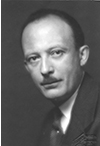Pierre Quesnay
( banker) | ||||||||||||
|---|---|---|---|---|---|---|---|---|---|---|---|---|
 | ||||||||||||
| Born | 1895 | |||||||||||
| Died | 8 September 1937 (Age 42) Saint-Léomer | |||||||||||
Cause of death | drowning | |||||||||||
| Nationality | French | |||||||||||
| Alma mater | Paris-Sorbonne University | |||||||||||
The first General Manager of the Bank for International Settlements.
| ||||||||||||
Pierre Quesnay was the first General Manager of the Bank for International Settlements, from the Bank's founding in April 1930 until his death by drowning on 8 September 1937.[1]
Education
Quesnay held a law degree from Paris-Sorbonne University.
Career
He was a member of the League of Nations Commission in Austria (1920-25), before becoming the Head of the Economic Analysis Department of the Bank of France (1926-29). He was a member of the Young Plan Commission (1929), and an expert for France at the Hague and London Conferences of 1929-30.
Bank for International Settlements
Pierre Quesnay played a leading role in the elaboration of the final statute of the Bank for International Settlements. In 1930, he became Director General of the BRI.
As he declared on February 18, 1931 in a lecture at The School of Peace by Louise Weiss, “the Bank for International Settlements is neither a European bank nor a universal world body like the League of Nations; it is an association of the central banks of the countries whose currency is based on gold and which, therefore, all have an interest in ensuring that the others maintain the same regime. He deduced from this that it was necessary "to work together or sink together into anarchy..." and concluded: "the modern capitalist world must therefore evolve today from the national economy to the international economy, or disappear" .
Quesnay then thought of giving the new BRI a broader mission than simply managing the financial problem posed by German reparations.
The use of the gold standard imposed on all countries in deficit the automatic return to equilibrium of external accounts. This imposed internal deflation.
From the summer of 1930, he presented in small internal conferences at the BRI his projects: to transform the BRI into a major international center the clearing of exchange allowing to ensure the regulation of international payments, public or private, by simple transfers of writing, without going through the foreign exchange markets. As he noted in his report discussed on May 19 and 20, 1931, he wanted to make the BIS “the central management body for international convertible assets”.[2]
Death
He "accidentally drowned" in Saint-Léomer on 8 September 1937, in a pond belonging to Émile Moreau, to whom he had come to seek advice. In the same September, he wondered if “monetary internationalism” had any meaning and was not part of a certain “financial romanticism”.[3]